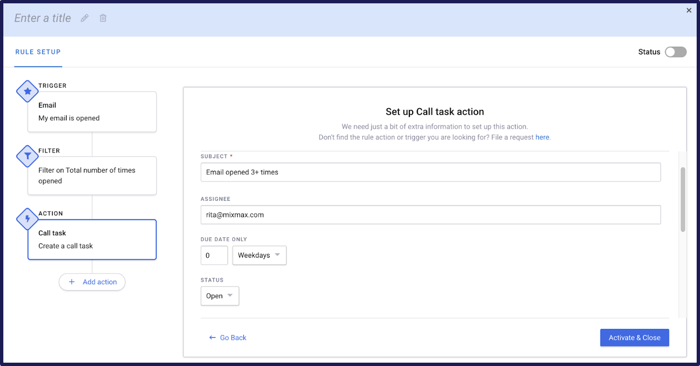Is cold calling dead? The simple answer is “no.” In fact, the only answer is “no.”
And we’re not talking about telemarketing calls that try to sell extended warranties on a 20-year-old washing machine that’s hanging on by a thread.
We’re talking about B2B cold calling.
As long as what you’re selling is legitimate, cold calling is NOT dead. And it fits beautifully into your multichannel prospecting strategy (more on that later).
If you’re an SDR, AE, or sales leader looking for sales call tips, you’ve come to the right place.
In this post, we extracted all the most compelling advice Jason Bay and Jack Wauson shared in their cold-calling masterclass. We’re talking call structure, opening lines, objections, you name it.
Here’s a breakdown of what’s covered (you can jump to whichever section you want) ⬇️
Is cold calling dead?
We’ll kick things off with a study conducted by RAIN Group, where they found that 57% of C-level executives and VPs list cold calling as their preferred method of being contacted.
Yes, you read that right.
Fifty-seven percent. AKA more than half.
And although the market is pivoting toward a more self-serve approach to sales, there is still need for cold prospecting, especially in B2B.
So nah, cold calling is here to stay.
With that out of the way, let’s dive into all the awesome advice Jason and Jack shared in their cold calling masterclass.
How many cold calls should you make?
According to Jason and Jack’s B2B cold calling experience, they emphasize the importance of high call volumes, suggesting that SDRs and BDRs aim for over 100 calls weekly. Even account executives, especially those self-sourcing, should target a minimum of 100 calls per week.
Cold calling cadence poll captured during the webinar
Setting cold calling objectives
Beyond the numbers, the discussion pivots to the objective of a cold call.
Rather than fixating on booking meetings, Jason and Jack urge sellers to build authentic conversations around the prospect’s needs, challenges, and priorities, aligning the conversation with what matters most.
Jason stresses the need to break the traditional dynamic between the seller who chases the buyer who runs away. Instead, initiate a genuine, permission-based dialogue.
They both agree that those initial 60 seconds in a cold call are make or break, and identify authenticity and empathy as key to keeping prospects hooked.
Pre-call research
Jack and Jason highlight the importance of thorough pre-call preparation. Here’s what they say you need to research about the prospect before calling:
- Industry
- Company
- Role
- Pain points
- Recent achievements
- Recent challenges
Doing this pre-call research positions the salesperson as someone genuinely interested in addressing the prospect's specific needs.
Jason also mentions you should meet the prospect in their world first. You have to get what matters to them, the stuff keeping them up at night. That way, sellers can steer the chat in a way that really resonates with the prospect.
Using phone calls in your multichannel prospecting strategy
Multichannel outreach is a MUST for modern sellers. If you only stick to email, you’re missing out on prospects who prefer to be contacted via other channels like phone and social.
If you use a sales engagement platform like Mixmax, you’ll be able to set up multichannel prospecting sequences that include automated emails, call tasks that can be triggered based on certain actions (like prospect clicked on a link or prospect opened your email 3x), LinkedIn connection requests, etc.
If we look at the call tasks specifically, here’s an example of what that looks like in Mixmax:

Mixmax call task
Plus, Mixmax has a built-in phone dialer that lets you make the call directly through the app or through Gmail, so you don’t have to use a third-party tool or context switch to complete your calls.
Mixmax in-app dialer
Mixmax Dialer in Gmail
All-in-one, baby.
Nailing your tone of voice
Cold calling is like riding a rollercoaster of excitement and nerves—no denying it. But according to Jack, it's all about keeping that cool, collected tone.
Staying calm lets sellers be quick on their toes, handle unexpected twists in the conversation, and build rapport with the prospect. Because, let's be real, prospects are more likely to vibe with someone confident and professional.
Jason and Jack throw in a pro tip, too: match the prospect's tone and energy. Make the chat feel like a breeze, so it flows naturally and feels comfortable for both parties.
Justin Michael on what tone to use when cold calling
Effective cold call opening lines (and ones to avoid)
As mentioned earlier, Jason suggests starting with a permission-based opener. What does that mean?
You ask for permission to continue the conversation.
Whatever you do, avoid these opening lines:
⛔️ "I was calling about [solution]."
⛔️ "I wanted to inquire if [solution] is top of mind."
⛔️ "I wanted to see if you’re interested in exploring our platform.”
⛔️ “Have you heard of [company] before?”
⛔️ “How’s your day going?”
Stick to these formats instead:
✅ Permission-based: “Hey, do you mind if I take a sec to tell you the reason for my call?"
✅ The Classic: "Hi David, it’s Jason. I know I’m catching you in the middle of your day. Do you have a minute for me to share why I'm calling? And then you can decide if you want to keep chatting?"
✅ The Gong opener: "Hi David, it’s Jason with Outbound Squad. I don’t suppose I caught you at the WORST time did I?” (a smile and slight chuckle are key with this one)
✅ Start with relevance: “Hi Jessie, I’m calling about all the hiring it looks like you’re doing in Canada right now. Oh, by the way, it’s Jason with Outbound Squad. Do you have a minute? I promise to be brief.”
✅ Armand Farrokh’s opener: “Hey Heather, we work with a few other construction firms in Texas. It's Jason at Outbound Squad. Have you heard our name tossed around?”
✅ Disarmingly blunt: “Hi Chelsea, it’s Jason. You're going to hate me. I’m cold-calling you, so please feel free to hang up on me if you need to. Was just hoping I could have 30 seconds to explain why I was reaching out?”
Handling instinctive vs. calculated objections
Jason lays it out: objections come in two flavors—instinctive and calculated.
Instinctive objections: These objections are reflexive and often occur without much thought. It's the immediate reaction, like swatting away a fly. Examples include "not interested," "busy right now," or "caught me in the middle of something." The buyer isn't necessarily consciously considering the objection; it's more of an automatic response to being interrupted.
How to handle instinctive objections: The key is to acknowledge the interruption and make the buyer feel heard. These objections are often more about the fact that the buyer doesn't want to be bothered at that moment. So, a friendly acknowledgment and a permission-based approach to continue the conversation can be effective.
Calculated objections: Unlike instinctive objections, calculated objections are more thoughtful and deliberate. Buyers have put some thought into their response, and it's often based on a specific reason or consideration. An example they discussed was when a buyer says they are already using a specific competitor's solution. This objection indicates that the buyer has made a conscious decision and might have evaluated options.
How to handle calculated objections: These require a more strategic approach. Instead of immediately countering the objection, the focus should be on understanding the buyer's perspective. For instance, if the objection is about using a competitor, greet it with enthusiasm, assume the best, validate their choice, and then elevate the conversation by sharing valuable insights that might align with their concerns or challenges.
Quick and dirty tips for handling the competitor objection
Here’s what you can do when your prospect drops the “I’m using [your competitor]" bomb:
- Don't dive into battle mode. Greet it with a smile.
- If they say "we're using XYZ," Jack suggests greeting it with enthusiasm. "That's awesome, you're on top of it!" But don't stop there, address the objection head-on.
- If they're using a competitor, assume they're acing it. Jack's playbook includes assuming they're at a perfect 10. But don't leave it there—validate. Confirm with the prospect, and they'll likely correct you, offering insights. Then, elevate the conversation. Share what others face in similar situations and the value they gain.
- Address the elephant in the room. "Hey, my goal is not to convince you to switch right now. I'm here to learn from you, and maybe, just maybe, share some insights that could make a difference. How about a quick chat?"
| Related post: 21 Common Sales Objections (& How to Respond to Them) |
Cold call follow-up best practices
1. Time is of the essence
Keep a mental timer ticking. When a conversation is hitting its peak, and you've covered the essentials, it's time to ask for the meeting. Don't let the prospect decide when the call ends—seize the moment.
2. Take the reins in transition
Transition smoothly by suggesting, "Do you mind if I make a quick suggestion?" or summarizing what you've discussed. Capitalize on the positive vibe and make your move. Be confident; the power is in your hands.
3. Bring them along
Instead of a flat "Let's set up a meeting," involve them in the journey. Express how the conversation has been productive, and propose a 30-minute session tomorrow. Make them feel part of the decision, building a collaborative dynamic.
4. Respond to the email request
When hit with a common "Can you send me an email?" request, don't rush to agree. Take a moment to understand their expectations. Ask what specific information they'd like in the email. This not only tailors your response but sets the stage for a more detailed follow-up.
5. Set expectations for email follow-up
If you agree to send an email, ensure you're clear on the next steps. Confirm what they expect in the email and set a follow-up call date and time. This not only manages their expectations but also keeps the conversation flowing.
6. Handle technical queries
For SDRs, it's okay not to be a product expert. If technical questions arise, acknowledge it and propose a deeper dive in a scheduled meeting. This positions your product specialists as valuable resources, fostering a team dynamic.
7. The triple confirmation technique
Before wrapping up the call, employ the triple confirmation method. Confirm the meeting agenda, confirm the calendar invite, and let them know you'll send a confirmation before the meeting. It minimizes miscommunication and ensures everyone is on the same page.
8. Leverage texting for quick confirmation
In the age of instant communication, texting is a powerful tool. Secure a triple confirmation, and if the meeting is a few days away, offer to send a text reminder. This not only reinforces the commitment but opens the door to future texting communication.
| Related post: The Ultimate Demo Follow-Up Email Guide (+ 7 Templates) |
Conclusion: Is cold calling dead? NOPE.
This post aimed to answer the question, “Is cold calling dead?” And the answer is a resounding "NO."
We're not talking about annoying telemarketing calls—this is about the art of B2B cold calling, and it's very much alive and kicking. In fact, it seamlessly integrates into your multichannel prospecting strategy, proving its enduring effectiveness.
Let's recap the key takeaways:
Quantity matters, aim high
- SDRs and BDRs should target over 100 calls weekly.
- Even account executives, especially those self-sourcing, benefit from a minimum of 100 calls per week.
Objective beyond meetings
- Shift the focus from booking meetings to building authentic conversations.
- Connect with prospects on their needs, challenges, and priorities.
Pre-call research pays off
- Thoroughly research industry, company, role, pain points, achievements, and challenges.
- Meet the prospect in their world first—understand what matters to them.
Multichannel all day
- Cold calling is not dead. Don’t just stick to emails—cast a wider net with multichannel outreach.
- Include call tasks based on specific actions in your sequences.
Mastering tone of voice
- Keep a cool, collected tone during the rollercoaster of cold calling.
- Match the prospect's tone and energy for a natural and comfortable conversation.
Crafty opening lines (and what to avoid)
- Start with a permission-based opener.
- Avoid common pitfalls like asking about their day or inquiring about solutions immediately.
Handling objections with precision
- Distinguish between instinctive and calculated objections.
- Address objections strategically based on their nature.
Competitor objection hack
- Greet competitor objections with a smile and enthusiasm.
- Assume the prospect is acing it with your competitor, validate, and elevate the conversation.
Cold call follow-up best practices
- Time is crucial—ask for the meeting when the conversation peaks.
- Take control in transition, suggest a follow-up, and capitalize on the positive vibe.
- Bring them along in the journey—propose a collaborative 30-minute session.
- Respond thoughtfully to email requests, understanding expectations.
- Set clear expectations for email follow-ups and subsequent calls.
- Don't fear technical queries; position product specialists as valuable resources.
- Triple confirmation technique—confirm agenda, calendar invite, and promise a confirmation.
- Leverage texting for quick confirmations and reminders.




.png?width=450&height=250&name=Episode%20Graphic%20(1).png)
